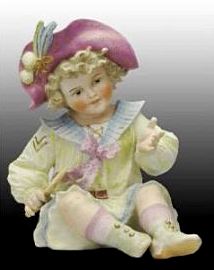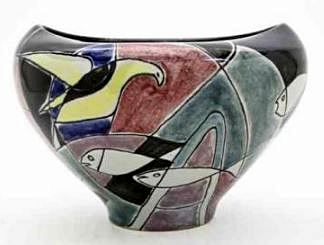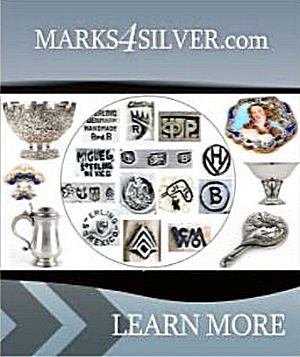PORCELAIN MARKS FROM GERMANY:
A Brief History of Porcelain Production in Germany

German porcelain factories and their marks have a rich and fascinating history that spans from the mid-18th century to the present day. The tradition of porcelain making in Germany began when Johann Friedrich Böttger and Ehrenfried Walther von Tschirnhaus discovered how to create true white porcelain in the early 1700s. This breakthrough allowed German porcelain manufacturers to produce pieces that rivaled those imported from China and other countries.
Meissen, located in Saxony, is perhaps the most well-known of all German porcelain factories. Founded in 1710 by Augustus the Strong, it is recognized as the first European factory to produce porcelain. Its famous crossed swords mark has become an iconic symbol of the brand and is still used to this day.
Other notable German porcelain manufacturers include Rosenthal, KPM (Konigliche Porzellan Manufactur) in Berlin, and the various companies in Volkstedt, Thuringia. These factories produced a wide range of porcelain pieces, from chinaware and dinnerware to figurines and decorative centerpieces. In addition, there are literally hundreds of smaller porcelain factories and studios that have produced magnificent works of art over the years.

One interesting aspect of German porcelain marks is the proliferation of imitations. Many porcelain decorating workshops and studios located around Dresden purchased porcelain blanks from the main Meissen factory and had them decorated by hand. These pieces were often decorated in the same style as Meissen, and the makers marks used by these studios often bear striking similarities to the original crossed swords marks used by Meissen. As a result, collectors should be careful when identifying whether an item is an authentic Meissen piece or an imitation.
Since the late 20th century, there has also been an increase in the number of items exported from other countries that use fake porcelain marks to make them appear authentic. These reproductions are often mass-produced and lack the fine workmanship and detailing found on examples coming from the original factories in Germany. Collectors should be cautious when purchasing these items and can often spot the differences quickly, or seek the opinion of specialists to confirm authenticity.
Tn addition to porcelain production, many German companies and studios also produced studio and art pottery, especially in the early to late 20th century. These pieces often bear unique pottery marks and are prized by collectors for their characteristic use of special glazes and textures. Some are mass-produced and intended for everyday use, while others are handcrafted works of art.
Aside from Meissen, Rosenthal, and KPM, there were also other prominent porcelain factories in Germany. For example, the town of Volkstedt in Thuringia was home to several porcelain factories, including one owned by Count von Hoym. Another notable factory was the Ludwigsburg Porcelain Manufactory, which was established in the mid-18th century by Duke Carl Eugen von Württemberg. This factory produced a wide range of porcelain items, including figurines, dinnerware, and vases, and was known for its exquisite decoration and attention to detail.
In addition to the major factories, there were also many smaller porcelain studios and workshops that produced high-quality pieces. These studios typically purchased porcelain blanks from the larger factories and then decorated them by hand. Many of these smaller studios were located in the area around Dresden, which was also home to the Meissen factory. Because the decoration style of these studios was often similar to that of Meissen, their marks can be easily confused with Meissen marks. However, there are several key differences between the two, and collectors can often identify whether a piece is authentic or not.

The Bauhaus School of Arts & Crafts pioneered and heavily promoted the trend of artisanal pottery in the 1920s, paving the way for much of the Modernist styled German pottery that dominated the market in the 1960s – 1980s. The combination of artisanal skill and modernist aesthetics produced some of the most striking and memorable pieces of German pottery.
However, the previously prolific production of porcelain items in Germany, including decorative masterpieces and chinaware, declined after the 1970s, as the popularity of other materials such as glass and plastic increased. However, there were still many companies and studios that continued to produce high-quality porcelain. In addition to dinnerware and figurines, German porcelain was also used to create a wide range of decorative items, including vases, lamps, and even clocks. Many of these items are highly sought after by collectors today, and can command high prices at auction.
It's important to note that not all porcelain items marked as "German" are authentic. In recent years, there has been an increase in the production of fake German porcelain items, particularly in countries like China. These items are often marked with fake porcelain marks in an attempt to make them appear authentic. However, these fake marks are often poorly done, and can be easily identified by collectors with a trained eye.
In conclusion, German porcelain has a long and rich history dating back to the 18th century. The country was home to several prominent porcelain factories, as well as many smaller studios and workshops. While porcelain production in Germany has declined in recent years, the country's rich tradition of porcelain-making lives on, and continues to be celebrated by collectors around the world.
Unlock the true value
of your collection with our comprehensive research guides from identifying makers' marks to appraising all kinds of
antiques and collectibles.
Our up-to-date information will give you an accurate understanding of your items' worth. Don't miss out on this
valuable resource - visit our research tools today!
Search our price guide for your
own treasures





